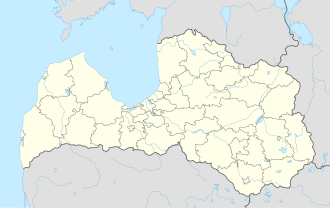Mazsalaca
Town in Latvia From Wikipedia, the free encyclopedia
Mazsalaca (pronounced [ˈmɑsːɑlɑtsɑ] ⓘ; Livonian: Piškisalāts, Estonian: Väike-Salatsi,[3] German: Salisburg) is a town in Valmiera Municipality in the Vidzeme region of Latvia. It has 1269 inhabitants.
Mazsalaca | |
|---|---|
Town | |
 Baznīcas Street in Mazsalaca | |
| Coordinates: 57°52′N 25°03′E | |
| Country | Latvia |
| Municipality | Valmiera Municipality |
| Town rights | 1928 |
| Area | |
• Total | 2.85 km2 (1.10 sq mi) |
| • Land | 2.79 km2 (1.08 sq mi) |
| • Water | 0.06 km2 (0.02 sq mi) |
| Population (2024)[2] | |
• Total | 1,113 |
| • Density | 390/km2 (1,000/sq mi) |
| Time zone | UTC+2 (EET) |
| • Summer (DST) | UTC+3 (EEST) |
| Postal code | LV-4215 |
| Calling code | +371 642 |
| Number of city council members | 9 |
| Website | http://www.mazsalaca.lv/public/eng/ |
History
The area includes the largest known Stone Age burial site in Northern Europe and was first settled ca. 5000 BC. The present town began to develop in 1864, when a bridge over the Salaca river was constructed.
During World War II, Mazsalaca was under German occupation from 4 July 1941 until 25 September 1944.[4] It was administered as a part of the Generalbezirk Lettland of Reichskommissariat Ostland.
In October 2009 a meteorite crater was found near the town,[5] which later turned out to be hoax as part of marketing campaign of telecommunication company Tele2.[6]
People
People who were born, lived in Mazsalaca:
- Gustavs Ērenpreiss (1891–1956) – manufacturer of bicycles
- Augusts Kirhenšteins (1876–1963) – microbiologist and educator
- Valters Hirte (1913–1983) – craftsman
- Ansis Epners (1937–2003) – film director
- Oskars Perro (1918–2003) – soldier and writer
See also
References
External links
Wikiwand - on
Seamless Wikipedia browsing. On steroids.


